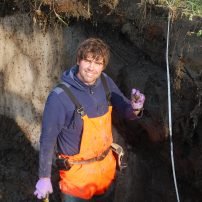
CACOON
How will changing freshwater export and terrestrial permafrost thaw influence the Arctic Ocean?
Description
Changing Arctic Carbon cycle in the cOastal Ocean Near-shore (CACOON)
Arctic rivers annually carry around 13% of all dissolved organic carbon transported globally from land to ocean, despite the Arctic Ocean (AO) making up only approximately 1% of the total Earths ocean volume. Arctic shelf waters are therefore dominated by terrestrial carbon pools, and their physical (e.g. stability, chemistry and circulation) and biological processes intimately linked to freshwater supplies. Arctic terrestrial ecosystems contain vast quantities of frozen carbon locked up underground, known as permafrost. These permafrost deposits represent one of the largest climate-vulnerable carbon pools globally, due to its susceptibility to thaw and mobilisation offshore in response to Arctic climate warming.
Rapid climate change is already resulting in permafrost thaw, sea-ice reduction and increasing riverine discharge over much of the pan-Arctic, triggering important feedbacks between terrestrial ecosystems and the AO. The importance of the entire near-shore region, consisting of several tightly connected ecosystems that include rivers, deltas, estuaries and the continental shelf, is however often overlooked and currently poorly understood. Seasonally-explicit studies are lacking severely limiting our ability to predict the impact of shifting seasonality, and of fresher waters, more concentrated nutrients and greater proportions of permafrost-derived carbon on coastal water processes and feedbacks. CACOON aims to address this knowledge gap by detailed investigations of the near-shore regions of the two major Arctic rivers which combined cover 19% of the entire pan-Arctic watershed area contributing to the AO.
CACOON Aims
CACOON will quantify the effect of changing freshwater export and terrestrial permafrost thaw on the type and fate of river-borne organic matter (OM) delivered to Arctic coastal waters, and resultant changes on ecosystem functioning in the coastal AO. We will achieve this though a combined observational, experimental and modelling study. We will conduct laboratory experiments to parameterise the susceptibility of terrigenous carbon to abiotic and biotic transformation and losses, then use the results from these to deliver a marine ecosystem model capable of representing the major biogeochemical cycles of carbon, nutrients and OM cycling in these regions. We will apply this model to assess how future changes to freshwater runoff and terrigenous carbon fluxes alter the biogeochemical structure and function of shelf ecosystems.
- generate novel seasonally-explicit datasets of OM source and transformation across the Kolyma and Lena River nearshore environments
- identify and parameterise key abiotic and biotic processes affecting terrestrial organic matter fluxes from land-to-ocean
- deliver projections of how future changes to freshwater runoff and terrestrial organic matter fluxes will alter the biogeochemical structure and function of shelf ecosystems.
Field campaigns on the Lena will be co-ordinated by Dr Jens Strauss (Alfred Wegener Institute, Germany), and by Dr Paul Mann (Northumbria University, UK) on the Kolyma River. Additional sample analysis and data will be obtained by a range of international project partners in Germany, UK, USA, Russia and Norway.
Lead Investigators
-
 View full profile
View full profileDr Paul James Mann
Co-lead investigator, Northumbria University
Paul Mann is senior lecturer in Biogeochemistry at the Department of Geography and Environmental Sciences, Northumbria University, and co-lead investigator of the CACOON project. Paul’s main focus is on aquatic and coastal carbon cycling in Arctic river systems, and how these will respond to future climate change. Within CACOON, Paul will aid in sample collection and geochemical analyses on the Kolyma River during transects out from the river to the coast.
-
 View full profile
View full profileDr Jens Strauss
Co-lead investigator, Alfred Wegener Institute (AWI)
Jens Strauss is a scientist at the Periglacial Research Unit of the Alfred Wegener Institute Helmholtz Centre for Polar and Marine Research, Potsdam, Germany. In the CACOON project he is the co-lead investigator, and responsible for identifying permafrost thaw end-members and quantifying how inputs of ancient-organic matter to aquatic systems relate to changes in terrestrial organic matter composition. Jens has been on many Arctic field expeditions in the North American and Russian Arctic, researching the vast permafrost domain of the former Beringian land mass, which was unglaciated during the last ice age.
Related Articles
-
Siberia’s permafrost erosion has been worsening for years
The Arctic is warming faster than any other region on the planet. As a result, permafrost that is thousands of years old is now being lost to erosion. Read more
16 September 2020 -
Jens Strauss talks about methane release from thawing permafrost
Dr Jens Strauss gave an interview today with Aktuelle Stunde about the climate impacts of warming in the Arctic on permafrost. Read more
08 August 2019

